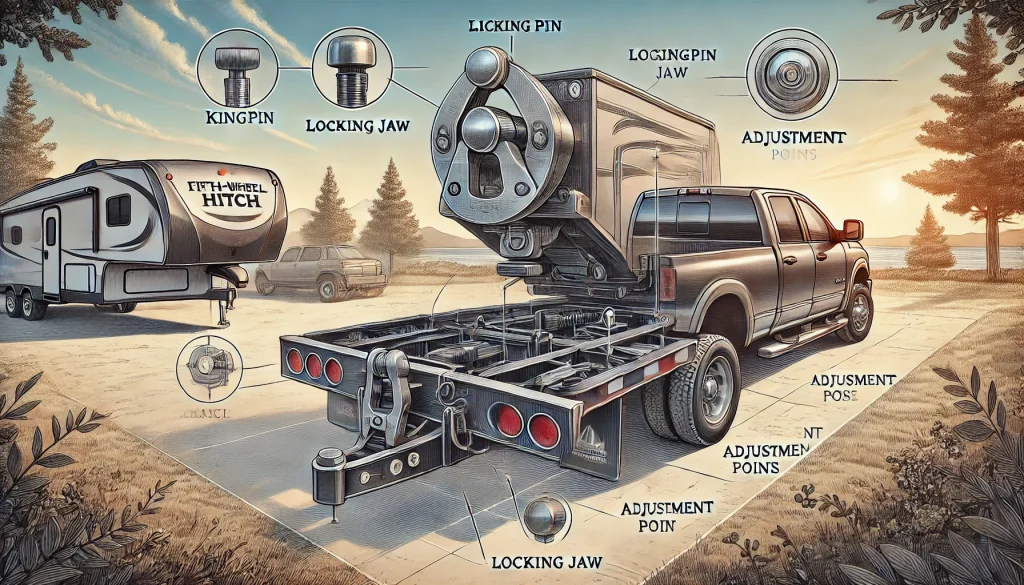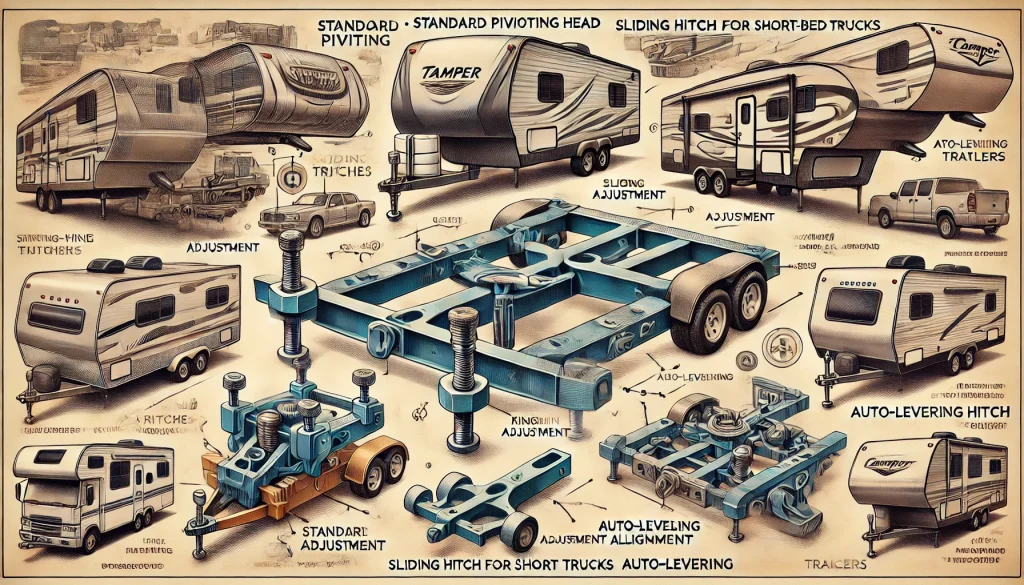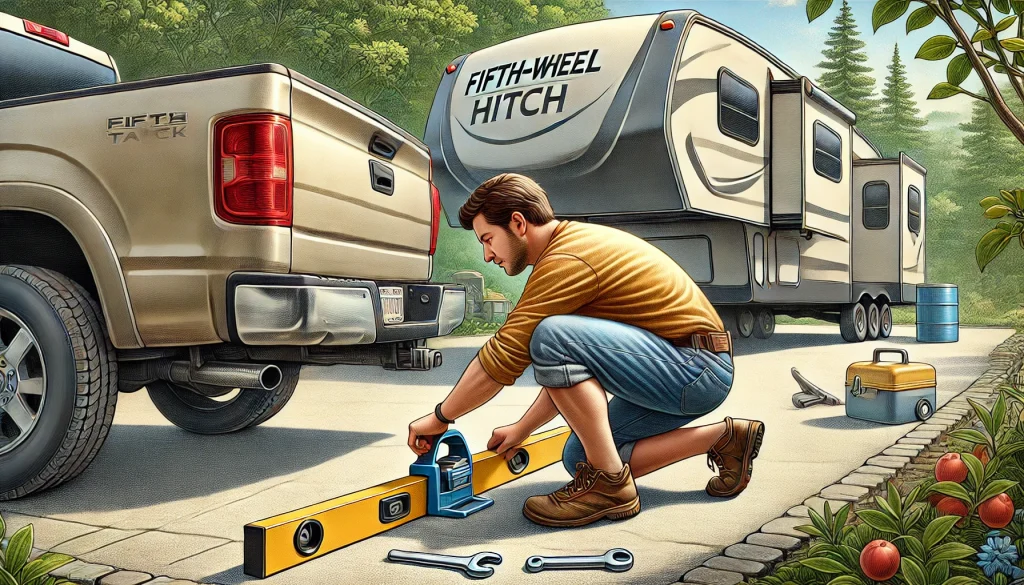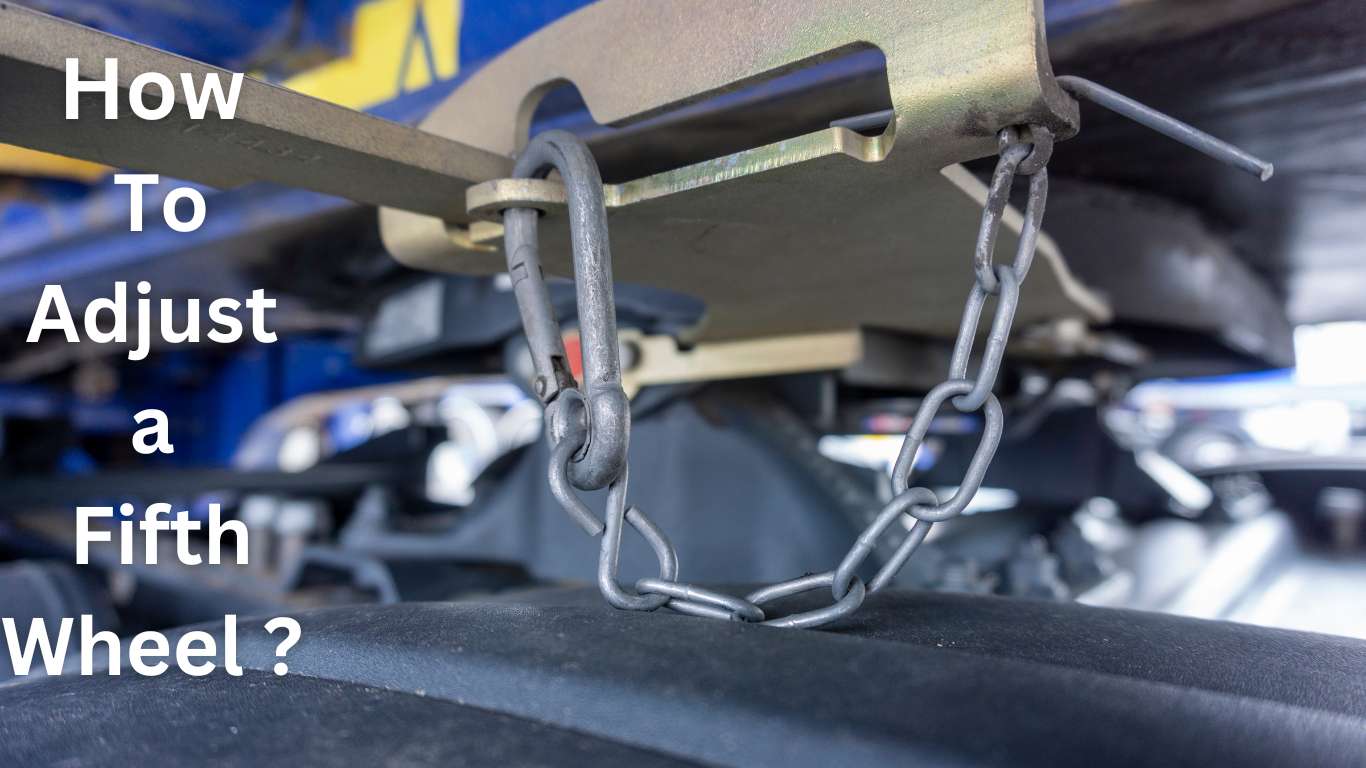Adjusting a fifth-wheel camper trailer is essential for ensuring safety and comfort during your travels. A properly adjusted fifth wheel improves towing stability, minimizes wear, and enhances your overall RV experience. Follow these step-by-step guidelines to adjust your fifth wheel effectively.
How Does a Fifth Wheel Work?
A fifth-wheel camper trailer works by using a unique hitching system that connects the trailer to a tow vehicle, typically a truck. This system ensures stability, maneuverability, and a secure towing experience, making fifth wheels a popular choice for RV enthusiasts.
The Basics of a Fifth-Wheel Hitch
What Is a Fifth-Wheel Hitch?
The fifth-wheel hitch is a specialized mechanism mounted in the truck bed. It uses a kingpin-and-coupler connection to secure the trailer. The kingpin, located on the trailer, locks into the coupler on the hitch, forming a pivot point.

Why It’s Called a “Fifth Wheel”
The term “fifth wheel” originates from horse-drawn carriages, where an extra wheel-like component allowed the front axle to pivot. In modern usage, it refers to the hitch system that acts as a “fifth wheel” for the towing setup.
How the Fifth-Wheel System Works
1. Hitching Process
- Align the Truck and Trailer: Back the truck until the kingpin on the trailer aligns with the hitch.
- Secure the Connection: The kingpin slides into the coupler, and the locking mechanism engages automatically.
- Perform a Tug Test: After hitching, perform a slow tug test to confirm the connection is secure.
2. Weight Distribution
- Over the Axle: The hitch is mounted directly over or just ahead of the truck’s rear axle. This placement distributes the trailer’s weight evenly across the truck’s frame, improving towing stability.
- Reduced Sway: The fifth-wheel design minimizes sway compared to bumper-pull trailers, providing a smoother and safer ride.
3. Turning and Maneuverability
- Pivot Point: The hitch’s pivot point allows for tighter turns, making fifth wheels easier to maneuver than traditional travel trailers.
- Sliding Hitches: For trucks with short beds, sliding hitches provide additional clearance during sharp turns to prevent contact between the trailer and the cab.

Key Advantages of a Fifth-Wheel System
Stability
Fifth wheels are more stable during towing because of their design, which reduces sway and ensures a smoother ride.
Greater Towing Capacity
The hitching system allows trucks to tow heavier loads, making fifth wheels ideal for large families or extended road trips.
Comfort and Convenience
The design offers better interior layouts, with features like over-the-bed sleeping areas and spacious living quarters.
Safety Tips for Fifth-Wheel Operation
Regular Inspections
Check the hitch, kingpin, and locking mechanism before every trip to ensure they’re in good condition.
Proper Weight Distribution
Avoid overloading the trailer and distribute weight evenly for safe towing.
Practice Maneuvering
If you’re new to towing a fifth wheel, practice turning and backing up in a controlled environment before hitting the road.
Are Fifth Wheels Adjustable?
Yes, fifth wheels are adjustable, and this adjustability plays a vital role in ensuring safe, smooth, and comfortable towing. From hitch height to leveling jacks, various components of a fifth-wheel camper trailer can be adjusted to optimize towing performance and stability.
What Makes Fifth Wheels Adjustable?
1. Adjustable Hitch Height
Fifth-wheel hitches are designed with adjustable height settings to align the hitch with the trailer’s kingpin. Proper alignment ensures a secure connection and helps maintain balance between the tow vehicle and the trailer.
2. Leveling Systems
Most fifth wheels come equipped with manual or automatic leveling systems. These systems allow you to adjust the camper’s leveling jacks to achieve stability, even on uneven terrain.
3. Sliding Hitches for Short-Bed Trucks
For short-bed trucks, sliding hitches are an excellent feature. These adjustable hitches provide extra clearance during sharp turns, preventing the camper from hitting the truck’s cab.
4. Suspension Adjustments
Some fifth-wheel trailers are equipped with adjustable suspension systems. These allow for height modifications, improving ride quality and handling on different road conditions.
Why Adjustability Is Important
Safe Towing
Adjustments help ensure the fifth wheel is securely connected, reducing the risk of sway or instability.
Enhanced Comfort
By fine-tuning the leveling and hitch alignment, you minimize vibrations and improve overall comfort during your trip.
Longevity of Your Fifth Wheel
Proper adjustments prevent unnecessary wear on the trailer’s components, extending the life of your investment.
How to Make Adjustments
Adjusting the Hitch
- Measure the hitch and kingpin height.
- Use the hitch’s height adjustment mechanism to align with the trailer.
Leveling the Camper
- Park on a flat surface.
- Deploy leveling jacks and use a bubble level to ensure balance.
Checking Clearance
- For short-bed trucks, slide the hitch backward during tight maneuvers.
- Confirm adequate space between the trailer and the truck cab.

Why Do You Need to Adjust a Fifth Wheel?
Adjusting a fifth-wheel camper trailer is a crucial step that ensures safety, stability, and comfort during your travels. Whether you’re a seasoned RV enthusiast or a first-time owner, understanding why fifth-wheel adjustments matter will enhance your towing experience.
The Importance of Adjusting a Fifth Wheel
1. Ensure Safe Towing
A properly adjusted fifth wheel improves towing stability by evenly distributing the weight between the camper and the tow vehicle. This prevents issues like swaying, jackknifing, or uneven braking, all of which could compromise safety on the road.
2. Optimize Driving Comfort
An unbalanced fifth wheel can cause vibrations, bumps, and excessive noise during your trip. Adjustments help create a smoother, quieter ride, reducing driver fatigue and wear on your vehicle.
3. Protect Your Fifth-Wheel Camper Trailer
Incorrect adjustments can stress your camper’s frame, axles, and tires. Proper alignment minimizes wear and tear, prolonging the life of your trailer and avoiding costly repairs.
When Should You Adjust a Fifth Wheel?
During Hitching and Unhitching
Each time you connect or disconnect your fifth wheel, adjustments are necessary to ensure the hitch height aligns perfectly with the kingpin.
After a Long Journey
Road vibrations can loosen connections or shift the alignment. Inspect and adjust your fifth wheel periodically, especially during extended trips.
On Uneven Ground
Parking on uneven surfaces requires adjusting the leveling jacks to ensure the trailer remains balanced and stable.
Tips for Proper Adjustment
Perform Regular Inspections
Inspect the hitch, kingpin, and leveling jacks to ensure they’re in good condition. Look for wear, cracks, or loose bolts.
Use Safety Tools
Utilize wheel chocks, bubble levels, and stabilizing blocks to secure and fine-tune your fifth wheel adjustment.
Follow Manufacturer Guidelines
Every fifth-wheel camper trailer has specific adjustment recommendations. Consult the owner’s manual for precise instructions tailored to your model.

How Do You Stabilize a Fifth Wheel?
Stabilizing a fifth-wheel camper trailer is essential to ensure comfort, safety, and durability during your camping trips. A stable fifth wheel prevents unwanted movement, reduces stress on the frame, and enhances your overall experience. Here’s how to stabilize your fifth wheel effectively.
Why Stabilization Matters
Prevents Sway and Movement
Even minor movements inside the camper can cause rocking, which can be unsettling and uncomfortable. Stabilizing eliminates this issue.
Protects Your Trailer
Proper stabilization reduces wear and tear on the fifth wheel’s structural components, extending its lifespan.
Improves Safety
A stable trailer minimizes the risk of accidents caused by shifting weight or instability during use.
Steps to Stabilize Your Fifth Wheel
1. Park on Level Ground
- Choose a Level Site: Whenever possible, park on a flat surface to minimize the need for adjustments.
- Use a Bubble Level: Check the trailer’s balance and reposition if necessary.
2. Deploy the Landing Gear
- Extend the Front Jacks: Lower the landing gear to stabilize the front of the trailer.
- Adjust for Balance: Ensure the trailer is level from front to back.
3. Use Wheel Chocks
- Place Chocks Around Tires: Install wheel chocks to prevent the trailer from rolling.
- Choose Heavy-Duty Chocks: Use durable, non-slip chocks for added security.
4. Set Up Stabilizer Jacks
- Extend Rear Stabilizers: Deploy the rear stabilizer jacks to eliminate rocking.
- Use Stabilizer Pads: Place pads under the jacks for better grip on uneven surfaces.
5. Install X-Chocks
- Tighten Between Tires: X-chocks fit between the tires and lock them in place, further reducing movement.
- Double-Check Fit: Ensure the chocks are tight but not overly compressed.
6. Consider Stabilizer Tripods
- Attach to Kingpin: Stabilizer tripods connect to the kingpin for additional front-end support.
- Adjust for Stability: Position the tripod firmly on the ground and lock it in place.

How to Adjust Different Types of Fifth Wheels for Various Camper Trailers
Adjusting a fifth wheel for different camper trailers requires knowledge of the specific hitch type, camper weight, and towing setup. Each adjustment ensures proper alignment, stability, and safety during travel. Here’s how to adjust various types of fifth wheels for different camper trailers.
Types of Fifth-Wheel Hitches
1. Standard Fixed Hitch
The fixed hitch is stationary and is commonly used for longer-bed trucks.
2. Sliding Hitch
Sliding hitches are designed for short-bed trucks, allowing extra clearance during sharp turns.
3. Auto-Sliding Hitch
This type automatically adjusts for turn clearance, reducing manual effort.
4. Gooseneck Adapter Hitch
Used when converting a gooseneck hitch to tow a fifth-wheel camper.
Adjusting Different Fifth-Wheel Hitches
1. Adjusting a Fixed Hitch
Fixed hitches are straightforward but require precise height alignment.
Steps:
- Measure Hitch and Kingpin Height: The hitch height must match the camper’s kingpin height for proper connection.
- Raise or Lower the Hitch: Adjust the hitch head position using mounting bolts.
- Check Bed Clearance: Ensure there’s 6-8 inches of clearance between the truck bed rails and the trailer to avoid damage.
2. Adjusting a Sliding Hitch
Sliding hitches allow the hitch to move back and forth for added clearance.
Steps:
- Align the Hitch and Kingpin: Back the truck until the hitch and kingpin are aligned.
- Set to Towing Position: Lock the hitch in the towing position when driving straight.
- Switch to Sliding Position: When preparing for sharp turns, unlock and slide the hitch back to avoid the camper contacting the truck’s cab.
3. Adjusting an Auto-Sliding Hitch
This hitch type simplifies adjustments by automatically sliding when turning.
Steps:
- Install and Calibrate: Ensure the hitch is correctly installed and calibrated according to the manufacturer’s guidelines.
- Check for Obstructions: Verify that the automatic slide operates freely and is not obstructed.
- Test the Sliding Mechanism: Perform slow turns in a safe area to confirm smooth operation.
4. Using a Gooseneck Adapter Hitch
Gooseneck adapters require careful adjustments to ensure compatibility with a fifth-wheel camper.
Steps:
- Install the Adapter: Attach the gooseneck adapter securely to the camper’s kingpin.
- Adjust the Hitch Ball Height: Ensure the hitch ball is at the correct height for a level connection.
- Test Stability: Perform a tug test to confirm the trailer is securely hitched.
Adjusting for Different Camper Trailers
Lightweight Campers
- Use a lower hitch setting for smaller trailers.
- Ensure the weight is evenly distributed to prevent instability.
Heavyweight Campers
- Check the hitch’s weight rating to ensure it matches the camper’s gross vehicle weight rating (GVWR).
- Adjust for maximum clearance and stability.
Extra-Long Campers
- For longer trailers, ensure the hitch is positioned directly over the rear axle or slightly forward.
- Consider a sliding or auto-sliding hitch for maneuverability.

How Can I Adjust a Fifth Wheel by Myself?
Adjusting a fifth wheel by yourself might seem challenging, but with the right tools and techniques, it’s a straightforward process. Proper adjustment ensures a secure connection, optimal towing performance, and a safer journey. Here’s a step-by-step guide to help you adjust a fifth wheel on your own.
Why Adjusting a Fifth Wheel Yourself Is Important
Safety First
A well-adjusted fifth wheel prevents sway, ensures stability, and minimizes the risk of accidents.
Save Time and Money
By learning how to make these adjustments yourself, you can avoid unnecessary trips to a mechanic and hit the road sooner.
Tools You’ll Need
- Bubble level
- Socket wrench or ratchet set
- Measuring tape
- Wheel chocks
- Stabilizer pads (optional)
Step-by-Step Guide to Adjusting a Fifth Wheel
1. Park on Level Ground
- Find a flat and stable surface to park your truck and trailer.
- Apply the parking brake to secure your tow vehicle.
2. Chock the Wheels
- Place wheel chocks around the trailer tires to prevent movement during adjustments.
3. Level the Trailer
- Use a bubble level inside the trailer to check its alignment.
- Adjust the landing gear or leveling jacks to bring the trailer to a level position.
4. Align the Hitch and Kingpin
- Measure the Hitch Height: Use a measuring tape to ensure the hitch height aligns with the trailer’s kingpin.
- Adjust the Hitch Height: Loosen the bolts on the hitch’s mounting brackets with a socket wrench. Raise or lower the hitch to match the kingpin height, then retighten the bolts.
5. Connect the Fifth Wheel
- Back Up the Truck: Slowly reverse the truck until the kingpin slides into the hitch’s coupler.
- Lock the Hitch: Ensure the locking mechanism engages securely.
- Perform a Tug Test: Gently pull forward to confirm the hitch is locked in place.
6. Check Bed Clearance
- Ensure there’s at least 6-8 inches of clearance between the truck bed rails and the trailer overhang to prevent damage during travel.
7. Stabilize the Fifth Wheel
- Deploy Stabilizer Jacks: Lower the stabilizer jacks at the rear of the trailer to minimize rocking.
- Use X-Chocks: Place X-chocks between the tires for added stability.
Pros and Cons: DIY vs. Professional Adjustment
| Aspect | DIY Adjustment | Professional Adjustment |
|---|---|---|
| Cost | Affordable (only tool costs) | Higher (service fees) |
| Convenience | Immediate adjustments possible | Requires scheduling |
| Expertise Needed | Moderate to high, depending on the task | None (handled by an expert) |
| Precision | May vary based on your skill level | High precision guaranteed |
| Complexity Handling | Limited | Ideal for advanced or custom setups |
Pro Tips for Adjusting a Fifth Wheel Alone
- Use Mirrors: Utilize your truck’s side mirrors and a backup camera (if available) to align the hitch with the kingpin.
- Double-Check Connections: Inspect the hitch, kingpin, and locking mechanism before starting your trip.
- Keep Tools Handy: Always carry your essential tools in case adjustments are needed during your journey.

Common Mistakes While Adjusting a Fifth Wheel
Adjusting a fifth wheel is essential for safe and efficient towing, but mistakes can compromise stability, safety, and comfort. By understanding the common errors and how to avoid them, you can ensure a smooth and stress-free towing experience.
1. Improper Hitch Height Adjustment
Mistake:
- Failing to align the hitch height with the trailer’s kingpin, leading to an uneven connection.
- Insufficient clearance between the truck bed and the trailer overhang.
Consequences:
- Uneven weight distribution increases the risk of trailer sway and impacts handling.
- Insufficient clearance can cause damage during tight turns or on uneven roads.
Solution:
- Measure the height of the hitch and kingpin with a tape measure before hitching.
- Ensure there’s at least 6-8 inches of clearance between the trailer overhang and truck bed rails.
2. Skipping the Tug Test
Mistake:
- Not performing a tug test after connecting the fifth wheel to the hitch.
Consequences:
- A loose or improperly latched hitch can lead to trailer detachment during travel, posing a serious safety hazard.
Solution:
- After locking the hitch, gently pull forward while keeping the trailer brakes engaged to confirm the connection is secure.
3. Over tightening or Under Tightening Bolts
Mistake:
- Tightening bolts excessively or leaving them too loose when adjusting the hitch or kingpin connections.
Consequences:
- Overtightened bolts can strip threads or damage components.
- Loose bolts can lead to instability and unsafe towing conditions.
Solution:
- Use a torque wrench to tighten bolts according to the manufacturer’s specifications.
4. Ignoring Weight Distribution
Mistake:
- Overloading the trailer or failing to balance the weight evenly.
Consequences:
- Unbalanced loads can lead to swaying, poor handling, and increased wear on tires and suspension.
Solution:
- Distribute weight evenly across the trailer, keeping heavier items closer to the axles.
- Stay within your truck and trailer’s gross vehicle weight rating (GVWR).
5. Using the Wrong Hitch Type
Mistake:
- Using a fixed hitch for a short-bed truck or a mismatched hitch for the trailer’s requirements.
Consequences:
- Limited turning radius can cause the trailer to hit the truck’s cab.
- An incompatible hitch can compromise safety and performance.
Solution:
- Choose a sliding hitch for short-bed trucks to allow for additional clearance during tight turns.
6. Neglecting Regular Inspections
Mistake:
- Failing to inspect the hitch, kingpin, or locking mechanism for damage or wear.
Consequences:
- Worn or damaged components can fail during towing, leading to accidents or breakdowns.
Solution:
- Regularly inspect all hitch components for cracks, rust, or loose parts, and replace any damaged items promptly.
7. Not Leveling the Trailer
Mistake:
- Skipping the leveling process during hitching or while parked.
Consequences:
- An unlevel trailer affects stability and causes discomfort inside the camper.
Solution:
- Use a bubble level to ensure the trailer is level front-to-back and side-to-side.
8. Rushing the Process
Mistake:
- Hurrying through adjustments without double-checking each step.
Consequences:
- Missing critical steps can lead to improper connections, instability, or unsafe conditions.
Solution:
- Take your time, follow a checklist, and verify every adjustment before setting off.

Should You Adjust Your Fifth Wheel Yourself or Hire a Professional?
When it comes to adjusting a fifth-wheel camper trailer, the decision to do it yourself or seek professional assistance depends on your experience, the complexity of the adjustment, and the equipment involved. While DIY adjustments can save time and money, professional expertise may be necessary in some cases.
DIY Adjustment: Is It the Right Choice?
Benefits of Adjusting Your Fifth Wheel Yourself
- Cost-Effective: You save money by avoiding professional fees.
- Convenience: Immediate adjustments can be made without waiting for appointments.
- Learning Opportunity: You gain valuable knowledge about your fifth-wheel setup.
When You Can Adjust Your Fifth Wheel Yourself
- Basic Adjustments: Aligning the hitch height, performing a tug test, and leveling the trailer.
- Routine Maintenance: Checking bolts, inspecting the kingpin, and ensuring proper clearance.
- Stabilization Setup: Using wheel chocks, stabilizer jacks, and leveling tools.
Requirements for DIY Adjustments
- A solid understanding of your fifth-wheel hitch and camper specifications.
- The right tools, such as a socket wrench, torque wrench, bubble level, and measuring tape.
- Confidence in following manufacturer guidelines and safety protocols.
When to Seek Professional Help
Complex Adjustments That May Require a Professional
- Hitch Installation: Installing or replacing a fifth-wheel hitch can be complex, especially for sliding or auto-sliding models.
- Frame Modifications: Adjustments involving the camper’s frame or suspension may need expert handling.
- Electrical and Hydraulic Systems: If your fifth wheel has advanced features like automatic leveling, professional calibration is advisable.
- Major Repairs: Worn-out or damaged components, such as the hitch coupler or kingpin, should be repaired or replaced by a professional.

Benefits of Hiring a Professional
- Expert Precision: Professionals have the experience to ensure accurate and safe adjustments.
- Time-Saving: Complex adjustments are completed faster and more efficiently.
- Safety Assurance: A professional can identify hidden issues that you might miss, reducing the risk of accidents.
More related details will be available on Flamingo Motorhomes.

